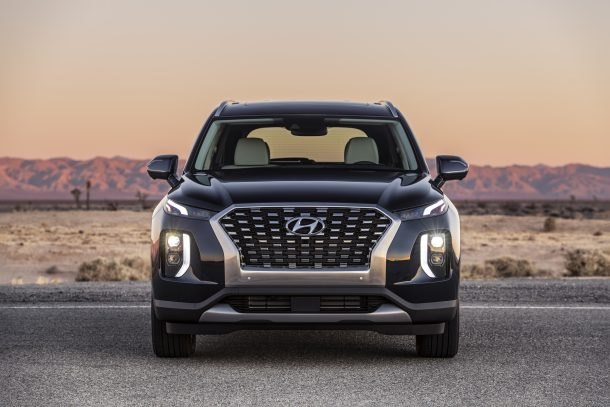Thank Heaven for Little (and Large) Crossovers: Hyundai's Recovery Continues Apace

It wasn’t long ago that Hyundai, having rocketed out of the recession on the strength of efficient — and newly improved — product, canned its American CEO over declining sales and made Operation Crossover its primary focus.
The sales slump was almost entirely the product of American buyers’ cold-shouldering of traditional passenger cars, to which Hyundai brass saw a utility vehicle surge as the only remedy. Seems they were right, as Hyundai’s now sitting pretty — and there’s another crossover that’s yet to land.
Hyundai reported a year-over-year U.S. sales gain of 8 percent in October, with retail sales up 12 percent. Year to date, sales are up 3.3 percent. Not bad considering the stagnant market. It helps when you’ve got new product on display, and Hyundai has two it’s particularly pleased with: the redesigned Santa Fe, which replaces the former Santa Fe Sport, and the Palisade, a three-row model that replaced the Santa Fe (renamed the Santa Fe XL after the Santa Fe Sport’s replacement by the Santa Fe — no confusion here!).
Despite the fact that Hyundai grouped both models under one name in its sales tallies, the new, singular Santa Fe’s sales were up 42 percent in October. Add in the 4,357 units of Palisade sold last month, plus remaining stock of old models, and Hyundai’s midsize(ish) crossover sales last month topped any month from 2018 or 2017. Through October, the nameplate is up 10.9 percent.
Meanwhile, the Tucson, despite its advancing age and looming successor, came within 205 units of matching last October’s volume. Through the end of October, Tucson sales are off 2018’s tally by just 822 vehicles. That’s one steady ship.
Further down the ladder, the Kona — Hyundai’s first salvo in Operation Crossover — outpaced last October’s tally by 27 percent, selling nearly as many vehicles as the midsize Sonata sedan. Put another way, it sold more than the Accent and Ioniq combined, and the same goes for year-to-date volume (only more so). Cars just aren’t cutting it in the Hyundai stable; high-volume models like the Elantra and Sonata are down significantly since the start of the year, though niche models like the Ioniq and Veloster are still in the black.
Next to arrive is an A-segment crossover called the Venue, aimed squarely at urban Millennials who love tech and efficiency but can’t find many coins to rub together. Offered as a front-wheel-drive-only vehicle, the Venue should arrive at dealerships any day now.
[Images: Hyundai]

More by Steph Willems
Latest Car Reviews
Read moreLatest Product Reviews
Read moreRecent Comments
- Kjhkjlhkjhkljh kljhjkhjklhkjh A prelude is a bad idea. There is already Acura with all the weird sport trims. This will not make back it's R&D money.
- Analoggrotto I don't see a red car here, how blazing stupid are you people?
- Redapple2 Love the wheels
- Redapple2 Good luck to them. They used to make great cars. 510. 240Z, Sentra SE-R. Maxima. Frontier.
- Joe65688619 Under Ghosn they went through the same short-term bottom-line thinking that GM did in the 80s/90s, and they have not recovered say, to their heyday in the 50s and 60s in terms of market share and innovation. Poor design decisions (a CVT in their front-wheel drive "4-Door Sports Car", model overlap in a poorly performing segment (they never needed the Altima AND the Maxima...what they needed was one vehicle with different drivetrain, including hybrid, to compete with the Accord/Camry, and decontenting their vehicles: My 2012 QX56 (I know, not a Nissan, but the same holds for the Armada) had power rear windows in the cargo area that could vent, a glass hatch on the back door that could be opened separate from the whole liftgate (in such a tall vehicle, kinda essential if you have it in a garage and want to load the trunk without having to open the garage door to make room for the lift gate), a nice driver's side folding armrest, and a few other quality-of-life details absent from my 2018 QX80. In a competitive market this attention to detai is can be the differentiator that sell cars. Now they are caught in the middle of the market, competing more with Hyundai and Kia and selling discounted vehicles near the same price points, but losing money on them. They invested also invested a lot in niche platforms. The Leaf was one of the first full EVs, but never really evolved. They misjudged the market - luxury EVs are selling, small budget models not so much. Variable compression engines offering little in terms of real-world power or tech, let a lot of complexity that is leading to higher failure rates. Aside from the Z and GT-R (low volume models), not much forced induction (whether your a fan or not, look at what Honda did with the CR-V and Acura RDX - same chassis, slap a turbo on it, make it nicer inside, and now you can sell it as a semi-premium brand with higher markup). That said, I do believe they retain the technical and engineering capability to do far better. About time management realized they need to make smarter investments and understand their markets better.


































Comments
Join the conversation
Looking back automotive historians will wonder how governments that mandated every manner of safety device could have let these view blocking mastodons onto roads filled with cars. They're a hazard to other drivers, to pedestrians and to the environment.
Art- I'm sure "whatnext" can't afford one anyway.......